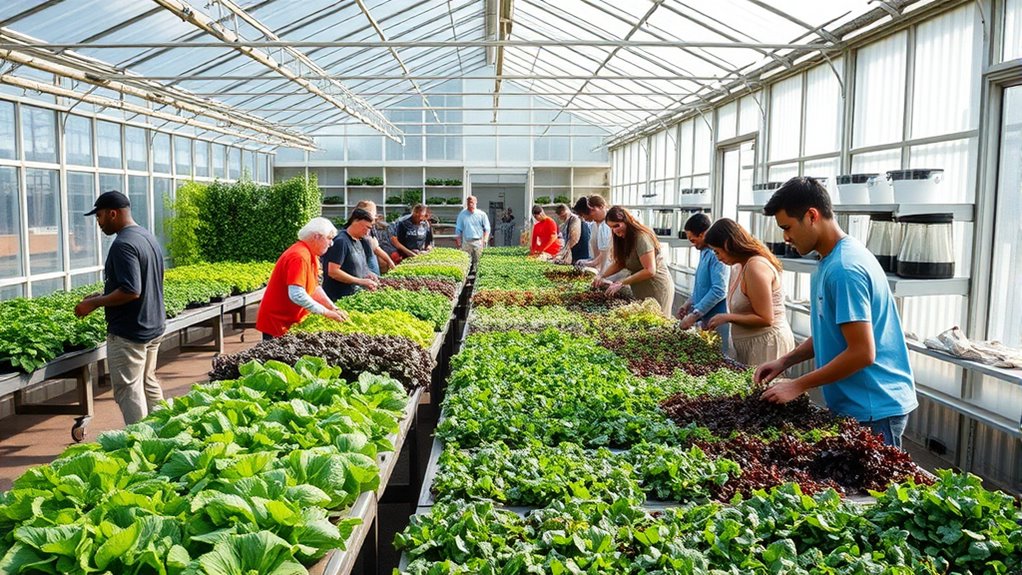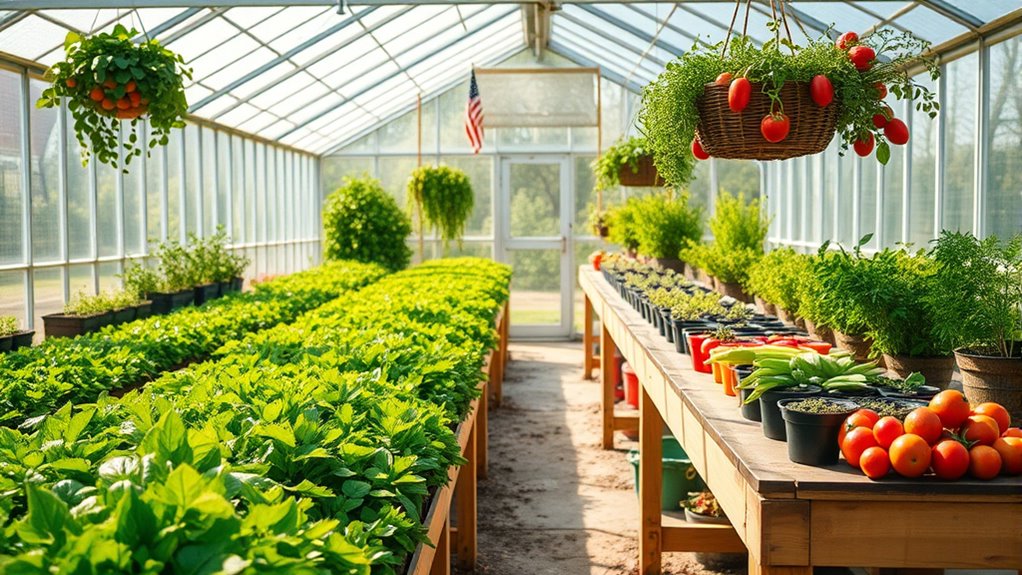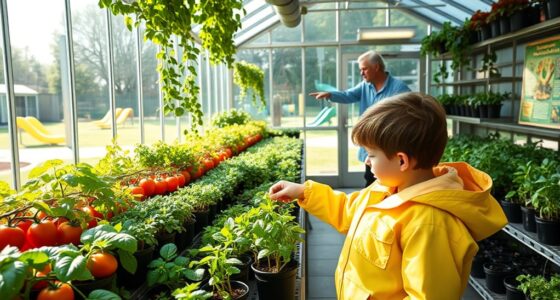Greenhouse co-ops let you grow fresh, sustainable produce right in your neighborhood year-round. By sharing costs and workloads, you reduce expenses and boost crop yields. These co-ops promote eco-friendly practices, cut food miles, and support local food systems. They also strengthen community bonds through collaborative farming and educational opportunities. If you’re interested in making your neighborhood greener and healthier, exploring how greenhouse co-ops work can open up exciting possibilities.
Key Takeaways
- Greenhouse co-ops enable year-round cultivation of fresh, local produce, extending growing seasons beyond outdoor limits.
- They reduce costs through shared resources, equipment, and maintenance among community members.
- Co-ops promote sustainable practices, lowering water use, chemical inputs, and transportation emissions.
- They foster community engagement, education, and connections around urban agriculture and environmental stewardship.
- Greenhouse co-ops support local food security and economic growth with resilient, community-driven food systems.

Have you ever considered pooling resources to make greenhouse gardening more affordable and productive? Greenhouse co-ops are an innovative way to bring fresh produce directly to your neighborhood while promoting sustainable farming practices. By joining forces with neighbors or local farmers, you can share the costs of equipment, seeds, and maintenance, making urban agriculture more accessible and efficient. This collaborative approach not only reduces individual expenses but also encourages community engagement and a sense of shared purpose. As a result, you contribute to a greener, more self-sufficient urban environment where fresh, healthy food is available year-round.
In a greenhouse co-op, each participant typically takes on specific roles, such as planting, watering, or harvesting, which streamlines operations and maximizes productivity. This system allows you to grow a variety of crops, from leafy greens to herbs, in a controlled environment that extends the growing season beyond traditional outdoor limits. Because greenhouses trap heat and protect plants from pests and harsh weather, you can produce higher yields with less water and fewer chemical inputs, aligning with sustainable farming principles. By practicing sustainable farming within a co-op, you’re reducing your carbon footprint, conserving resources, and supporting local food systems. Additionally, implementing dream journaling techniques can help participants develop patience and mindfulness, which are beneficial for maintaining consistent effort in community projects.
Urban agriculture thrives when communities harness the power of greenhouse co-ops. They transform vacant lots or unused spaces into productive gardens that supply fresh produce to local markets and residents. This effort helps cut down food miles, lowering greenhouse gas emissions associated with transporting food over long distances. Plus, it fosters local economic growth by creating opportunities for small-scale farmers and entrepreneurs. When you participate in or organize a greenhouse co-op, you’re actively contributing to a resilient urban food network that emphasizes organic methods, composting, and eco-friendly pest management.
Joining a greenhouse co-op also offers educational benefits. You learn sustainable farming techniques and gain hands-on experience in urban agriculture, empowering you to grow your own food more effectively. It’s a chance to connect with like-minded individuals who value environmental stewardship and community health. As you share knowledge and resources, you’re helping to build a sustainable model of food production that can inspire other neighborhoods to follow suit. Over time, co-ops can expand, incorporating more diverse crops and innovative practices, strengthening the local food system and promoting food security.
In essence, greenhouse co-ops are a smart, community-driven solution to making fresh, locally grown produce more affordable and accessible. They embody sustainable farming principles and demonstrate how urban agriculture can thrive when people come together to share resources and ideas. By participating in or supporting such initiatives, you’re helping create a more sustainable, resilient, and connected neighborhood—one where everyone has access to nutritious food grown with care for the environment.
Frequently Asked Questions
How Are Greenhouse Co-Ops Funded and Sustained Financially?
You might wonder how greenhouse co-ops stay financially sustainable. They often rely on community investment, where local residents and businesses contribute funds, and they seek grant opportunities to support their operations. These sources help cover costs like equipment, seeds, and staff. By building strong community support and securing grants, co-ops create a stable financial foundation that guarantees they can consistently provide fresh produce to your neighborhood.
What Types of Produce Are Typically Grown in Greenhouse Co-Ops?
You’ll find greenhouse co-ops typically grow a variety of produce, including hydroponic vegetables and seasonal herbs. These co-ops focus on crops that thrive in controlled environments, providing fresh, local options year-round. By growing hydroponic vegetables, they maximize space and reduce water use, while seasonal herbs add flavor and variety. This diverse produce selection helps meet community needs while promoting sustainable farming practices.
How Can Neighborhoods Start Their Own Greenhouse Co-Op?
To start your own greenhouse co-op, you should gather neighbors interested in fresh produce and focus on community engagement. Form a cooperative governance structure, like a steering committee, to plan and manage the co-op. Secure funding, choose a suitable location, and organize shared responsibilities. This collaboration helps everyone benefit from locally grown, fresh produce while fostering a stronger community connection.
What Are the Environmental Benefits of Greenhouse Co-Ops?
Imagine your neighborhood as a thriving garden, where every plant contributes to a healthier ecosystem. Greenhouse co-ops support urban farming, reducing the need for long-distance food transport and lowering pollution. They also enhance biodiversity benefits by creating diverse, sustainable growing spaces that attract beneficial insects and pollinators. This eco-friendly approach helps conserve resources, improve air quality, and strengthen your community’s resilience to climate change.
How Do Greenhouse Co-Ops Ensure Food Safety Standards?
Greenhouse co-ops guarantee food safety standards by implementing strict pest management practices and crop rotation strategies. You can trust that they regularly monitor for pests and diseases, reducing the need for harmful chemicals. They also rotate crops to prevent soil depletion and minimize disease buildup. These methods help maintain healthy, safe produce for your community, ensuring that your food is both fresh and safe to eat.
Conclusion
Joining a greenhouse co-op connects you to a vibrant garden of community and fresh produce. As you share in the growth and harvest, you become part of a thriving ecosystem where food and friendship flourish. It’s like planting seeds of change that blossom into healthier, greener neighborhoods. So, step into this fertile ground, and watch how your neighborhood blooms with the warmth of collaboration and the bounty of nature’s best.










